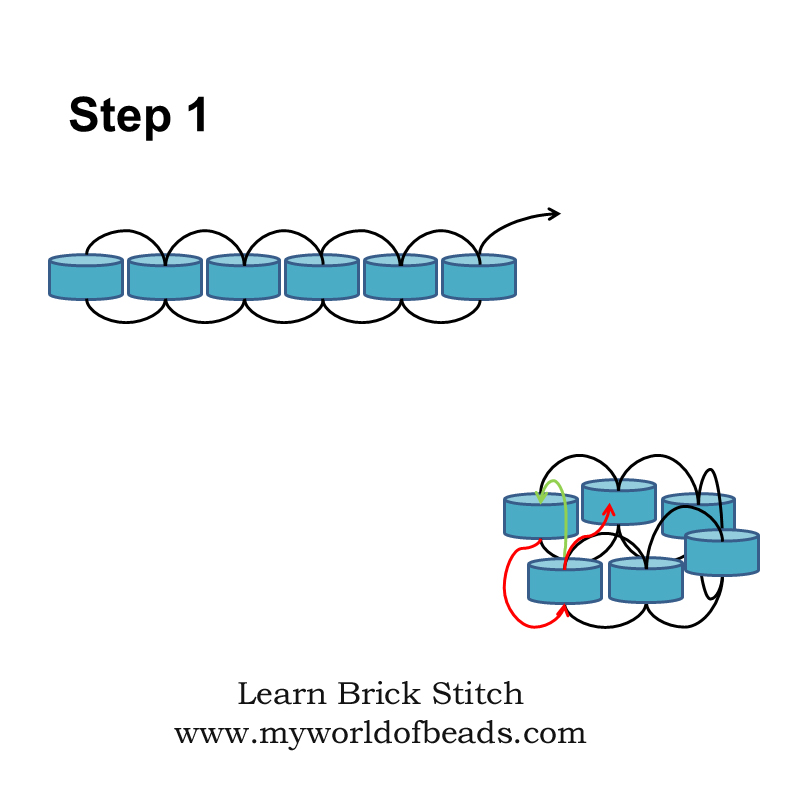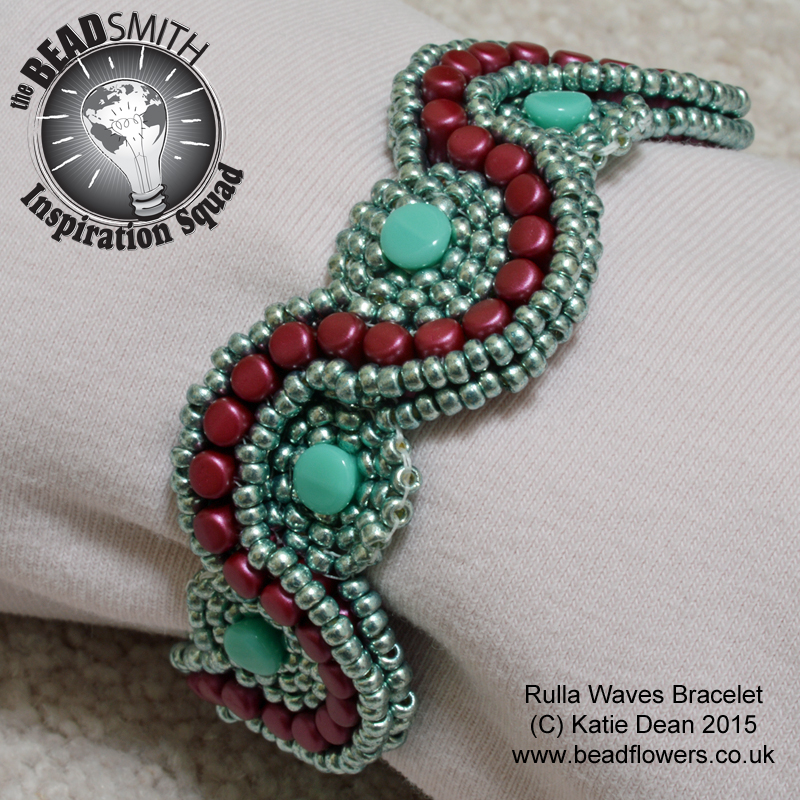Learn Circular Brick Stitch
If you’re following along through all my brick stitch tutorials, I think it’s now time for you to learn circular brick stitch.
This is just a ‘baby’ step on from my last tutorial which covered increasing and decreasing in the middle of the row. The only reason I split this out is because the way in which you start circular brick stitch is quite specific.
So, before you continue with this mini lesson, make sure you understand how to make an increase. Just take a look at this blog if you need a reminder.
Learn circular brick stitch start
I invite you to think about the circular variation of any beading technique that you know. Generally speaking, they all begin by threading a certain number of beads and passing through them to form a circle. From that point, you follow whichever thread path is applicable to your chosen technique.
Now, have a little think about what you know about starting brick stitch. You probably remember, you have a couple of options: using ladder stitch, or using a Peyote variation. The point is, you will end up with a string of beads that sit ‘side by side’. So, how do you deal with the idea of joining those into a circle?
Step 1
So, bearing this in mind, as you begin to learn circular brick stitch, here is the first lesson. You would need to create your first row using the ladder stitch technique. The Peyote start won’t work because you won’t be able to curve two rows into a circle!
So, start by adding 6 beads using ladder stitch.
Then, fold your string of beads into a circle so that bead 6 is next to bead 1. Use the ladder stitch thread path (red and green arrows in the right-hand section on the diagram), to join the two end beads.

So, you now have a circle to start with. But this still leaves you with a problem…
The starting conundrum…
The thing is, brick stitch is built by adding beads onto a line of thread, rather than by linking new beads to existing beads. So, if you want to create a flat circle, the threads need to be sitting around the outside ‘edge’ of the circle, not on top and bottom.
You’ve probably already made this discovery for yourself. As you joined beads 1 and 6, the beads flipped themselves to they were sitting side by side with the threads pointing up and down. So, how are you going to build your beads outwards towards the green circle? I’ve illustrated this in the right-hand diagram.

Now, what you actually want is for your beads to have rolled themselves outwards, so that the threads are sitting inside and outside the circle. Then, you can add brick stitch rows onto the outside threads and build out towards your green circle. So, this is the ideal in the left-hand diagram.
In order to achieve this, you need enough beads in your string so that you can roll them onto their sides and still have the thread sitting around the outside edge. So, what is that magic number of beads?
Truth be told, I have no idea. But I do know it will take quite a lot of beads. So, this leaves you with a new problem…
How would you fill the centre of your circle?
If, as you learn circular brick stitch, you use this starting method, you are going to be left with a big hole in the centre. So, how would you fill that in?
Again, I don’t have a specific answer. Maybe you freeform it…?
Or, do you just leave it empty and create a ‘ring’ rather than a ‘circle’?
My point is, brick stitch is actually not set up for creating a flat circle – or even a ‘not flat’ circle (a cone!)…
Unless, you do something a little different to start off…
Learn circular brick stitch start that actually works!
So, here’s the cunning plan… Find a round bead. It could be a sphere (like a pearl), or it could be a flat disc. Then, take a fresh look at the concept of brick stitch.
This technique is all about using a line of thread as a basis for adding new beads. So, you don’t need any beads in your start, just some thread!
Now, let’s really get on to learn circular brick stitch…
Step 1
Let’s try step 1 again…
Take your round bead and thread through it. Pass your thread around the outside edge and tie the working thread to your tail thread. Then, pass through the bead again. Ease your visible thread to the left-hand side of the bead. Then, take your thread around the outside of the right-hand side of the bead and through the bead once more.

So, you have a tail thread hanging out of the bottom of your bead and a visible thread all the way around the outside of the bead (with three thread passes through the bead). You are exiting from the top of your bead.
Step 2
Now, use your basic brick stitch technique to add a row of beads around the outside edge of your circle. In each stitch, you are going to hook under the exposed thread from step 1.
 Now, one thing to remember… When you are working in brick stitch normally, you have distinct pieces of thread joining between beads. So, you know exactly where to sit your new beads.
Now, one thing to remember… When you are working in brick stitch normally, you have distinct pieces of thread joining between beads. So, you know exactly where to sit your new beads.
With this set up, you just have a continuous line of thread. So, you have no idea how many beads are going to be in that first row around your circle.
If you are following a pattern, it should tell you how many beads to add. But if you are trying this on your own, you’ll need to just work it out. So, take care – if you add too many beads, that first line will pucker so the beads don’t sit flat next to one another.
If you add too few beads, you will end up with gaps between them. So, you might find yourself having to experiment a little and try adding or removing a bead or two to get the right fit.
Step 3
When you have a comfortable number of beads around the circle, you need to complete your row by joining the last bead to the first bead. So, simply pass from the last bead, down through your first bead, then up through the last bead again.

Step 4
You are now ready to work in the circular brick stitch that you will use for all your remaining rows.
Basically, you will now add a new row, just as normal. But, in order to keep your circle growing outwards, flat, you will need to make some increases in this row.
Again, if you are following a pattern, it should tell you how many increases to make. If you’re working this out on your own, then you need to use your intuition again.
So, first of all, add your first stitch, then you can make an increase in the next stitch. If you need a reminder of how to make an increase, pop over to this blog (it will open in a new window). Basically, you are just going to add your new bead so that it shares the same thread as your previous bead.
 Now, continue with the row, making increases wherever you need to.
Now, continue with the row, making increases wherever you need to.
If that sounds a little scary, think about these rules…
- Make your increases at regular intervals around the circle (eg, every third bead, or every fifth bead)
- Try to ‘read’ the beads. So, if you keep your new row sitting as flat as possible, you will see points where your thread looks like it needs two beads joined onto it. This would be an indication that you need to make an increase.
- When you reach the end of the row, check that it is sitting flat and doesn’t have any big gaps. If it looks right, then it’s all good. If it looks wrong, try and work out if you need to add or remove a bead or two.
Step 5
When you have your beads in place to your satisfaction, repeat step 3 to finish this row.
 You can see in my example, I made three increases (the dark blue beads – sharing the same thread as their neighbour, marked x). I spread them evenly around the row, so my shape retains its circular look.
You can see in my example, I made three increases (the dark blue beads – sharing the same thread as their neighbour, marked x). I spread them evenly around the row, so my shape retains its circular look.
Explorations…
As you continue to learn circular brick stitch, you can start to explore. What happens if you line all your increases up over one another (ie increase in row 3 on top of the increase position in row 2)? Or should you place the increases in row 3 in slightly different places?
If you make four increases in each row, and line them up, will this turn your circle into a square?
Practise!
The best way to really learn circular brick stitch is to keep practising. So, now you’ve learned the basics and had a little chance to experiment, let me offer you a couple of projects to try.
This bracelet pattern builds several brick stitch circles, then uses Rulla beads to link them into a design. You can use this link to get a copy of the bracelet pattern.
You don’t have to start circular brick stitch with a round bead… If you want to take your experiments a little further, this kit uses circular brick stitch built around cubes, to make chocolate chip cookies!

What next?
If you would like a PDF that you can save and print out, this link takes you to a free tutorial. You can also bookmark this page to return to whenever you need to.
And, if you love your beading friends, share this website with them too!
Hopefully you have enjoyed this opportunity to learn circular brick stitch. So, don’t stop here! Use this link to try out some other variations of brick stitch and master this technique in no time!












